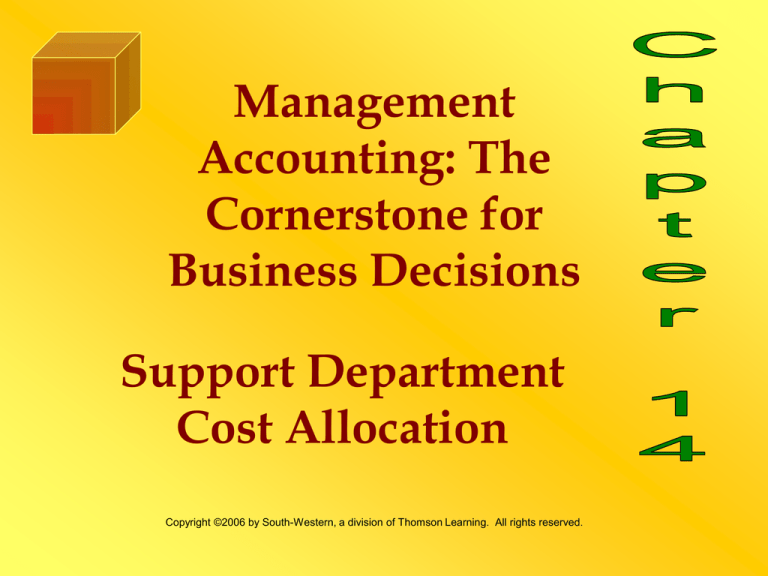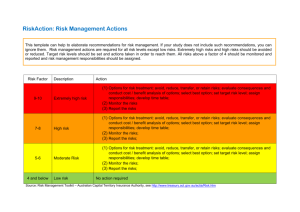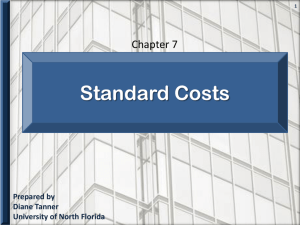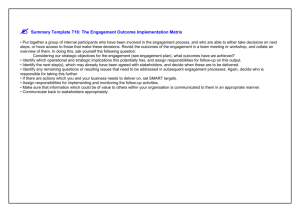
Management
Accounting: The
Cornerstone for
Business Decisions
Support Department
Cost Allocation
Copyright ©2006 by South-Western, a division of Thomson Learning. All rights reserved.
Learning Objectives
1. Describe the difference between
support departments and producing
departments.
2. Calculate single and multiple charging
rates for a support department.
3. Assign support department costs to
producing departments using the direct,
sequential, and reciprocal methods.
4. Calculate departmental overhead rates.
Match Definitions
Producing
Dept.
Cost drivers that measure use or
consumption of support services
Support
Dept.
Costs that are directly traceable
to a specific department
Causal
Factors
Direct
Costs
Provides essential support
services to producing departmts.
Responsible for directly creating
a product or service sold to a
customer
What are the steps for determining
product costs using predetermined
overhead rates?
1. Departmentalize the firm
2. Classify each department as support or
producing
3. Trace all costs in the firm to a support or
producing department
4. Assign support department costs to producing
departments using cost drivers that measure
consumption of support department services
5. Calculate predetermined overhead rates for
producing departments
6. Assign overhead costs to the units of individual
products using the predetermined overhead
rates
What are the objectives of
assigning support department
costs?
1. To obtain a mutually agreeable price
2. To compute product line profitability
3. To predict the economic effects of
planning and control
4. To value inventory
5. To motivate managers.
How to calculate and use a
14-1
single charging rate.
Budgeted cost of Kuma & Buttons copying department:
Fixed costs : $20,000 per year (machine rental & maintenance)
Variable costs: $0.05 per page copied (paper and toner)
Budgeted usage:
Actual usage:
Pages
Pages
Audit
120,000
128,000
Compliance
90,000
82,000
Fraud
90,000
95,000
Total
300,000
307,000
How to calculate and use a
14-1
single charging rate.
REQUIRED: Calculate a single charging rate and use this
rate to assign the costs of the copying department to the
user departments based on both budgeted and actual usage.
Discuss the service usage performance of the producing
departments.
Calculation: Single charging rate:
Total budgeted cost of the copying department:
Fixed costs:
$20,000
Variable costs (300,000 x $0.05) 15,000
Total
$35,000
Budgeted single rate = $35,000 / 300,000 = 0.1167 per page
How to calculate and use a
14-1
single charging rate.
Assignment based on budgeted usage (budgeted service
cost-needed as a performance benchmark and for product
costing):
The budgeted amount charged to the producing departments
is calculated as follows:
Audit
Compliance
Fraud
Total
Number of
Pages
120,000
90,000
Charge
per Pages
$0.1167
0.1167
Total
Charges
$14,004
10,503
90,000
300,000
0.1167
10,503
$35,010
How to calculate and use a
14-1
single charging rate.
Assignment based on actual usage (actual service costs – to
be compared with the budgeted service costs).
The actual amount charged to the producing department is
calculated as follows:
Number of
Charge
Total
Audit
Compliance
Pages
128,000
92,000
per Pages
$0.1167
0.1167
Charges
$14,938
10,736
Fraud
Total
95,000
305,000
0.1167
10,736
$36,410
Illustrate Allocation
Relationships
14-2
How to calculate and assign
service costs using multiple
charging rates.
Budgeted cost of Kuma & Buttons copying department:
Fixed costs : $20,000 per year (machine rental & maintenance)
Variable costs: $0.05 per page copied (paper and toner)
Estimated
Budgeted:
Actual:
Peak Usage
Usage
Usage
(Monthly)
Pages:
Pages:
Pages:
Audit
9,200
120,000
128,000
Compliance
25,000
90,000
82,000
Fraud
7,800
90,000
95,000
Total
42,000
300,000
307,000
14-2
How to calculate and assign
service costs using multiple
charging rates.
REQUIRED: Assign copying cost to the producing
departments using variable and fixed rates based on both
budgeted and actual usage
Calculation: Fixed cost assignment (assigned in proportion
to peak usage for both budgeted and actual usage cases):
Peak # Proportion of Total Fixed Amount Assigned
of pages
Peak Usage
Costs
to Each Dept.
Audit
9,200
0.219
$15,000
Compliance 25,000
0.595
15,000
Fraud
7,800
0.186
15,000
Total
42,000
Total cost assignment = Variable + Fixed
$3,285
8,925
2,790
$15,000
14-2
How to calculate and assign
service costs using multiple
charging rates.
Budgeted usage (Budgeted costs for performance benchmark
and product costing):
Audit
Compliance
Fraud
Total
Number of
Pages
Number of
Pages X $0.04
Fixed Cost
Assignment
Total
Charges
120,000
90,000
90,000
300,000
$4,800
3,600
3,600
$12,000
$3,285
8,925
2,790
$15,000
$8,085
12,525
6,390
$27,000
14-2
How to calculate and assign
service costs using multiple
charging rates.
Actual usage (Actual costs for comparison with planned
performance):
Audit
Compliance
Fraud
Total
Number of
Pages
Number of
Pages X $0.04
Fixed Cost
Assignment
Total
Charges
128,000
82,000
95,000
307,000
$5,120
3,280
3,800
$12,200
$3,285
8,925
2,790
$15,000
$8,405
12,205
6,590
$27,200
Define Direct Method of
Cost Allocation
14-3
How to assign support department
costs using the direct method.
Support
Power
Depts.
Maint.
Direct Costs
Variable
$180,000 $150,000
Fixed
120,000
80,000
Expected Activity
Kilowatt hrs.
0 200,000
Mainten. hrs.
1,000
0
Percent of Peak
capacity required
Maintenance
Power
Producing
Grinding
Depts
Assembly
$75,000
25,000
$20,000
40,000
700,000
4,500
300,000
4,500
75%
65%
25%
35%
14-3
How to assign support department
costs using the direct method.
REQUIRED: Using the direct method, assign the support
department costs to the producing departments using a
single-rate approach and a dual-rate approach. For the
dual-rate approach use peak capacity to assign fixed costs.
Calculation:
Power: 700,000 / (700,000 + 300,000)
Grinding
70%
300,000 / (700,000 + 300,000)
Maint.: 4,500 / (4,500 + 4,500)
4,500 / (4,500 + 4,500)
Assembly
30%
50%
50%
14-3
How to assign support department
costs using the direct method.
Using a single rate approach:
Support Dept.
Producing Dept.
Power
Mainten.
Grinding
Assembly
Direct costs
$300,000
$230,000
$ 75,000
$ 20,000
Power
(300,000)
210,000
90,000
115,000
115,000
$400,000
$225,000
Maintenance
Total
$
-
(230,000)
-
$
-
14-3
How to assign support department
costs using the direct method.
Using a dual-rate approach
Support Dept.
Power
Direct costs
$
300,000
Producing Dept.
Mainten.
Grinding
$230,000 $ 75,000
Assembly
$ 20,000
Var. cost. assign.
Power
(180,000)
Maintenance
-
(150,000)
126,000
54,000
75,000
75,000
90,000
30,000
52,000
28,000
$418,000
$207,000
Fix. cost. assign.
Power
(120,000)
Maintenance
Total
-
$
-
(80,000)
$
-
14-4
How to assign support department
costs using the sequential method.
Support
Power
Depts.
Maint.
Direct Costs
Variable
$180,000 $150,000
Fixed
120,000
80,000
Expected Activity
Kilowatt hrs.
0 200,000
Mainten. hrs.
1,000
0
Percent of Peak
capacity required
Maintenance
Power
20%
Producing
Grinding
Depts
Assembly
$75,000
25,000
$20,000
40,000
700,000
4,500
300,000
4,500
75%
50%
25%
30%
14-4
How to assign support department
costs using the sequential method.
REQUIRED: Using the sequential method, assign the
support department costs to the producing departments
using a single-rate approach and a dual-rate approach. For
the dual-rate approach use peak capacity to assign fixed
costs.
Calculation:
Maint. Grinding
Assembly
Power:
200,000 / (200,000 + 700,000 + 300,000)
700,000 / (200,000 + 700,000 + 300,000)
16.67%
58.33%
300,000 / (200,000 + 700,000 + 300,000)
Maint.: 4,500 / (4,500 + 4,500)
4,500 / (4,500 + 4,500)
25.00%
50%
50%
14-4
How to assign support department
costs using the sequential method.
Using a single rate approach:
Support Dept.
Power
Direct costs
$
Power
Maintenance
Total
$
Producing Dept.
Mainten.
Grinding Assembly
300,000
$230,000
$
75,000
(300,000)
50,010
$ 20,000
174,990
75,000
-
(280,010) 140,005
140,005
-
$
-
$389,995
$235,005
14-4
How to assign support department
costs using the sequential method.
Using a dual-rate approach
Direct costs
Power
Mainten.
Grinding
Assembly
$300,000
$230,000
$ 75,000
$ 20,000
30,006
104,994
45,000
(180,006)
90,003
90,003
24,000
60,000
36,000
-
(104,000)
67,600
36,400
-
$
$397,597
$227,403
Var. cost. assign.
Power
(180,000)
Maintenance
-
Fix. cost. assign.
Power
(120,000)
Maintenance
Total
$
-
How to calculate and use
14-4 departmental overhead rates.
Summary of the single rate sequential cost assignment
Producing Departments
Grinding
Assembly
Direct costs
$100,000
60,000
Power cost assign.
174,990
75,000
Maint. Cost assign.
140,005
140,005
$414,995
275,005
Machine hrs. (expected level)
71,000
Assembly hrs. (expected level)
107,500
One unit of Product Alpha uses 2 machine hours in the
Grinding Department and 3 hours in the Assembly
Department
How to calculate and use
14-4 departmental overhead rates.
REQUIRED: Calculate the departmental overhead rates
using machine hours for grinding and assembly hours for
assembly. Using the rates, determine the overhead costs
assigned to one unit of product A.
Calculation:
Overhead rate (Grinding) = $414,995 / 71,000 = $5.845 per MH
Overhead rate (Assembly) = $275,005 / 107,500 = $2.558 per
Assembly hour
Product A unit overhead cost = ($5.845 x 2) + ($2.558 x 3)
= $19.364






